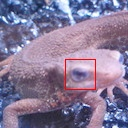使用误差平方和算法(Sum of Squared Difference,简称SSD)进行模式匹配(Template Matching).
在这里我们使用误差平方和进行模式匹配。将imori_part.jpg在imori.jpg中匹配的图像使用红框框出来。
模式匹配,即寻找待匹配图像和全体图像中最相似的部分,用于物体检测任务。现在虽然使用卷积神经网络(CNN)来检测物体,但是模式识别仍然是最基本的处理方法。
下面介绍具体算法。原图像记为I(H\times W),待匹配图像为T(h\times w):
- 对于图像I:,
for ( j = 0, H-h) for ( i = 0, W-w)在一次移动1像素的过程中,原图像I的一部分I(i:i+w, j:j+h)与待匹配图像计算相似度S。 - S最大或最小的地方即为匹配的位置。
S的计算方法主要有 SSD、SAD、NCC、ZNCC等。对于不同的方法,我们需要选择出最大值或者最小值。
在这里我们使用误差平方和SSD(Sum of Squared Difference)。SSD计算像素值的差的平方和,S取误差平方和最小的地方。
S=\sum\limits_{x=0}^w\ \sum\limits_{y=0}^h\ [I(i+x,j+y)-T(x,y)]^2
顺便说一句,像模式匹配这样,从图像的左上角开始往右进行顺序查找的操作一般称作光栅扫描(Raster Scan)或者滑动窗口扫描。这样的术语在图像处理邻域经常出现。
可以使用cv2.rectangle ()来画矩形。另外,imori_part.jpg稍微改变了颜色。
python实现:
import cv2
import numpy as np
import matplotlib.pyplot as plt
# Read image
img = cv2.imread("imori.jpg").astype(np.float32)
H, W, C = img.shape
# Read templete image
temp = cv2.imread("imori_part.jpg").astype(np.float32)
Ht, Wt, Ct = temp.shape
# Templete matching
i, j = -1, -1
v = 255 * H * W * C
for y in range(H-Ht):
for x in range(W-Wt):
_v = np.sum((img[y:y+Ht, x:x+Wt] - temp) ** 2)
if _v < v:
v = _v
i, j = x, y
out = img.copy()
cv2.rectangle(out, pt1=(i, j), pt2=(i+Wt, j+Ht), color=(0,0,255), thickness=1)
out = out.astype(np.uint8)
# Save result
cv2.imwrite("out.jpg", out)
cv2.imshow("result", out)
cv2.waitKey(0)
cv2.destroyAllWindows()
输入(imori.jpg):

template图像(imori_part.jpg):

输出:

 极客教程
极客教程